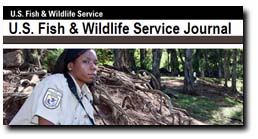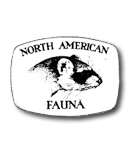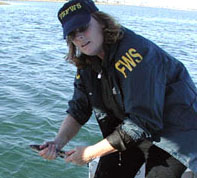
Newsroom
News Releases & Photos 
News releases issued from the Pacific Southest Regional Office (Region 8) are delivered via an automated fax/email system. If you would like to receive our news releases, please send us an email with your name, email address or fax number. For news releases from our field offices in California and Nevada, notify the public affairs contacts listed below.
9/13/12 - New Plan Will Help Tiny Foxes Continue Big Steps Toward Recovery
9/13/12 - New Report Shows Rise in Hunting, Fishing and Wildlife-Related Recreation Participation in 28 States
9/5/12 - Eagle Lake Trout May Warrant Protection under the Endangered Species Act
RSS News Feeds

|
|
 |
 |
 |
 |
 |
 |
Regional News Photos & Images
National Digital Media Library
PACIFIC SOUTHWEST REGION FACEBOOK PAGE
Regional Newsletter
We Are the Pacific Southwest Region ( Web 1 MB ) is a quarterly newsletter that highlights the activities and people of the Service's Pacific Southwest Region.
To download, you'll need Adobe Acrobat version 8 or later.
The Fish & Wildlife Journal
 Looking for "soft news," story ideas or information about Fish and Wildlife Service activities and accomplishments in the field? Try the Fish & Wildlife Journal website. The Fish & Wildlife Journal includes an online searchable database that contains hundreds of employee-written summaries of field activities and other accomplishments.
Looking for "soft news," story ideas or information about Fish and Wildlife Service activities and accomplishments in the field? Try the Fish & Wildlife Journal website. The Fish & Wildlife Journal includes an online searchable database that contains hundreds of employee-written summaries of field activities and other accomplishments.
additional publications
 Journal of Fish and Wildlife Management
Journal of Fish and Wildlife Management
The Journal of Fish and Wildlife Management includes an online searchable database that contains scientific papers on the practical application and integration of science to conservation and management of North American fish, wildlife, plants and their habitats.
 North American Fauna
North American Fauna
North American Fauna includes monographs on an array of topics relating to North American vertebrates, invertebrates and plants including descriptions of groups of taxa, ecosystems, or complex interactions among species and basic research on species life history, distribution, population dynamics and taxonomy.
 Eddies
Eddies
Eddies seeks to inform its readers of the work -- past, present, and future -- of the U.S. Fish and Wildlife Service's Division of Fisheries and Aquatic Resource Conservation. Each issue
has several feature stories and five regular departments.
 Agency Overview
Agency Overview
Conserving the Nature of America: The U.S. Fish and Wildlife Service is the premier government agency dedicated to the conservation, protection, and enhancement of fish, wildlife and plants, and their habitats.
The Endangered Species Bulletin was created in 1976 to meet the growing demand for endangered species program news. Through the Bulletin, the U.S. Fish and Wildlife Service disseminates information on rulemakings, recovery plans and activities, conservation partnerships, research developments, and a variety of other issues. It is distributed on-line four times per year.
Pacific Southwest Region External Affairs
The primary focus of the Region 8 staff is on strategic public communications issues at the Regional level. We also provide communications and outreach expertise to project leaders in the field, and support outreach and communications efforts of public affairs staff organic to Fish and Wildlife Offices in California and Nevada.
Paul McKim, Assistant Regional Director, External Affairs
Phone
(916) 978-6619
Scott Flaherty, Deputy Assistant Regional Director, External Affairs
Phone
(916) 978-6156
Pamela Bierce, Public Affairs Officer
Phone (916) 414-6542
Jon Myatt, Web Communications Manager, Public Affairs
Phone (916) 414-6474
Alene Thomas, Executive Assistant
Phone
(916) 414-6498
External Affairs Fax: (916) 414-6486
Field Office Public Affairs Contacts
Bay-Delta Fish and Wildlife Office
916-930-5643
Steve Martarano, Public Affairs
Carlsbad Fish and Wildlife Office
760-431-9440 ext. 205
Jane Hendron, Division Chief
Stephanie Weagley, Outreach and Information
Coleman National Fish Hatchery
530-365-8622
Desert National Wildlife Refuge Complex
702-515-5480
Daniel Balduini, Public Affairs
Hopper Mountain National Wildlife Refuge Complex
805-644-5185
Michael Woodbridge, Information and Education
National Fire Program Outreach
530-934-2801
Miriam Morrill,
Public Outreach, Sacramento NWR Complex
Nevada Fish and Wildlife Office
775-861-6300
Jeannie Stafford, Public Affairs
Sacramento Fish and Wildlife Office
916-414-6571
Sarah Swenty, Public Affairs
San Francisco Bay National Wildlife Refuge Complex
510-72-0222, ext. 143
Doug Cordell, Public Affairs
Ventura Fish and Wildlife Office
805-644-1766 ext. 332
Lois Grunwald, Public Affairs
Yreka Fish and Wildlife Office
530-842-5763
Matt Baun, Public Affairs
pacific southwest region in the News
Working for the Plover
The Pacific Coast western snowy plover is a small shorebird distinguished from other plovers (family Charadriidae) by its small size, pale brown upper parts, dark patches on either side of the upper breast, and dark gray to blackish legs. Snowy plovers weigh between 1.2 and 2 ounces. They are about 5.9 to 6.6 inches long. The Pacific Coast population of the western snowy plover breeds primarily on coastal beaches from southern Washington to southern Baja California, Mexico. Biologists estimate that no more than 2,270 snowy plovers breed along the Pacific Coast of the United States with approximately an equal number breeding on the west coast of Baja California. The largest number of breeding birds occurs south of San Francisco Bay to southern Baja. The species' decline has been attributed to loss of nesting habitat, human disturbance, encroachment of European beach grass (Ammophila arenaria) on nesting grounds, and predation. Urban development has reduced the available habitat for western snowy plovers while increasing the intensity of human use, resulting in increased disturbance to nesting plovers. For more information: http://www.fws.gov/oregonfwo/Species/Data/WesternSnowyPlover/
This text is replaced by the Flash video. If you see this text please visit www.adobe.com and download the Flash Player browser plugin.
Precious Step Toward Condor Recovery
In a sandstone cliff band at the edge of Hopper Mountain National Wildlife Refuge in southern California, California condor #107 guards his week-old chick from U.S. Fish and Wildlife Service biologists who arrived to survey the nesting site. The nest of condor #107 and his mate, #161, is one of five in Southern California this year (2009). Condor #107 (a.k.a. Ushkal), a 15-year-old adult, was born at the Los Angeles Zoo and released into the wild near Bitter Creek NWR. Condor #161, a 12-year-old female, was born at the San Diego Wild Animal Park and released near Big Sur in Central California. The California condor was listed as an endangered species in 1967. By 1982 only 23 existed in the world. As a result of intensive public and private conservation efforts and captive breeding programs, more than 80 condors fly free in central and southern California, 70 in Arizona and 15 in Baja, Mexico. The goal of the California Condor Recovery Plan is to establish two geographically separate populations, one in California and the other in Arizona, each with 150 birds and at least 15 breeding pairs.
This text is replaced by the Flash video. If you see this text please visit www.adobe.com and download the Flash Player browser plugin.
Witness the Winter Migration
National Wildlife Refuges in California and Nevada provide migratory birds with places to rest, nest and feed. The Sacramento Valley National Wildlife Refuge near Willows, California, is one of several refuges in the region that provide opportunities for the public to "connect with nature" and witness the awe-inspiring migration close-up. Located 90 miles north of Sacramento, the Sacramento refuge complex provides winter resting and feeding areas for nearly half of all migratory birds on the Pacific Flyway. Three million ducks and a million geese migrate here. The refuge hosts interpretive tours and birding events January through April.
"Leave No Child Inside"
A growing number of children's advocates and political leaders are worried that our culture's disconnection from nature is harming kids. This concern has caused the Fish and Wildlife Service and other government agencies to engage in a movement to "leave no child inside." KQED public television's QUEST program explores why we need nature, and efforts to encourage children to play outdoors. This segment orignally aired Monday, May 12, 2008. More on this topic is available on the QUEST website.
Learn about the Fish and Wildlife Service's "Let's Go Outside" initiative to Connect Children With Nature. Find a National Wildlife Refuge near you.
"Condors vs Lead Bullets"
External Affairs & NCTC contributed to this 10 minute video produced by KQED's "QUEST" series that examines the affects of lead on condor health. This program aired on KQED Feb. 20, 2007. FWS Condor Recovery partner, Ventana Wildlife Society, is featured in the video. The video aired prior to changes in California law in 2008 restricting lead ammunition in condor range.
Visit Hopper Mountain National Wildlife Refuge, home to the Service's California condor recovery program.
Tis the Season for Migrating Birds

USFWS Photo
Each fall, millions of birds travel south compelled by changes in food availability, habitat and weather. Healthy waterfowl habitats are critical for this passage to remain uninhibited. What are the conditions of these habitats and how can humans assist this natural flow? KALW-FM radio host Rose Aguilar discusses the fall migration with Brad Bortner, chief of the migratory bird division at the Pacific Region in Portland, Ore.and Beth Huning, San Francisco Bay Joint Venture. (Originally broadcast Oct. 6, 2008)
Listen to the Podcast (55:35)
Learn more about the Service's Migratory Bird Program
San Francisco Bay Joint Venture
Special Agent Nets World's #1 Butterfly Smuggler

USFWS Photo
Special Agent Ed Newcomer of the Torrrance, Calif., Law Enforcement Office recounts a 3-year investigation of the world's most wanted butterfly smuggler for National Public Radio's Weekend Edition that aired May 27, 2007.
Listen to Ed's NPR interview
Read the news release
Learn more about federal wildlife law enforcement
Investigation Nets Leopard Shark Smugglers

USFWS Photo
Special Agent Lisa Nichols of the San Diego Law Enforcement Office is featured in this NPR story about the investigation and prosecution of a Bay area church that smuggled thousands of protected leopard sharks from San Francisco Bay. This story aired nationally on February 13, 2007.
Listen to Lisa on the NPR story
Read the news release
Learn more about federal wildlife law enforcement


 Endangered Species Bulletin
Endangered Species Bulletin